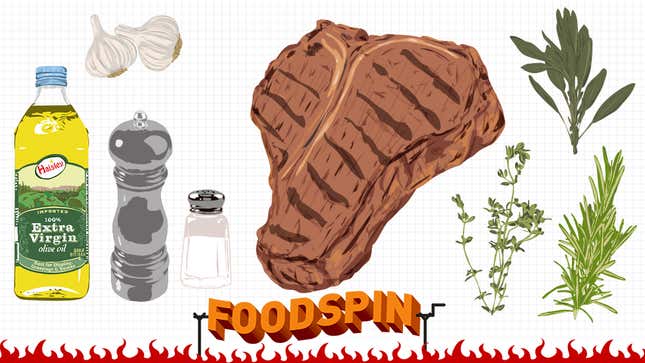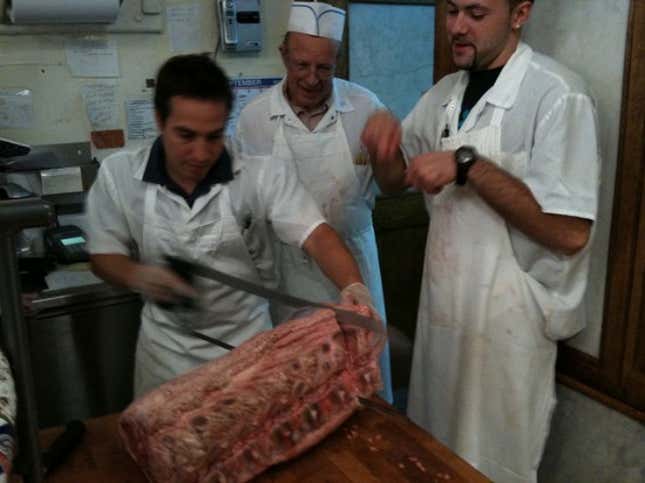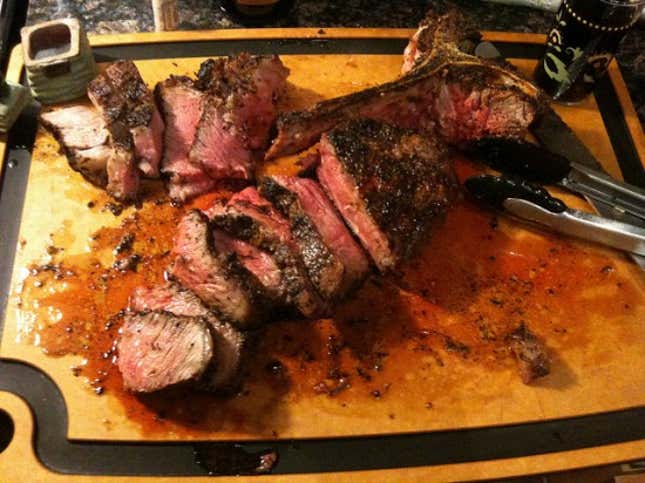
Albert Burneko is off. Your guest Foodspinner this week is writer and Drynuary evangelist John Ore.
Spring means it's almost summer, and summer means grilling, and grilling means steak (among other things, but certainly steak). And while there's nothing more fun than firing up the ol' Weber kettle and absently poking at your very own bone-in ribeye while five of your closest friends armchair-tong over your shoulder, there's nothing quite like the community of grilling something delicious that everyone can share. But what are you going to do with those lava-hot coals once the flank steak is done? Stare at them for 30 minutes while their life- and flavor-giving potential slowly burns out?
Not on my watch.
Even when done right, a good, hot charcoal fire (no, there's no other kind) can be kind of a pain in the ass to get going—so why waste it cooking something that is on and off the grill in five to seven minutes? Yes, you could—and should!—grill corn and ramps and snow peas and asparagus and garlic scapes and a bunch of other rabbit food to take advantage of those glowing embers. But how about we grill a bistecca all Fiorentina—a giant T-bone-style steak the size of your entire head that takes 20 minutes to cook, is served bloody as hell, serves four to six, and can be eaten with your fingers?
Let's stare at a fire and a hunk of meat long enough to finish three beers. The way our ancestors intended.
You'll need:
- one T-bone steak, at least 3 inches thick (three to three and a half pounds)
- one tablespoon fresh rosemary leaves, chopped
- one tablespoon fresh sage leaves, chopped
- one tablespoon fresh thyme leaves
- four cloves garlic, roughly chopped
- two tablespoons freshly ground black pepper
- two tablespoons kosher salt
- two tablespoons of the best extra virgin olive oil you can find
(Recipe adapted from Mario Batali.)
You're not likely to find a three-inch T-bone just hanging around wrapped in cellophane on a styrofoam tray listening to muzak at your local Piggly Wiggly; this means that you'll have to find a reputable butcher who can cut a giant T-bone for you to order. Watching someone whip out a friggin' hacksaw to prepare your food is incredibly satisfying and primal; this will help take the sting out of the $75 you're going to shell out for it.

Now, pay attention here: There's a difference between a T-bone and a porterhouse cut, but either can be used for our purposes. T-bones come from one end of short loin (a big cut from a little more than halfway down the back of a poor cow), and porterhouses from the other. Both include a bit of tenderloin (your Filet Mignon) on one side of the T-shaped bone, and a loin strip (your NY strip) on the other. The difference is how much. T-bones, since they come from the front part of the short loin, are dominated by the strip steak, with much smaller filets—sometimes just a bite or two. Porterhouses (from the other end of the short loin, remember) have more filet, but still pack sizable strip steaks. As a result, T-bones can appear longer and pointier, while porterhouses are more heart-shaped. Which one you'll go for is a matter of personal preference; just get your butcher to hack you off a cut that's as thick as the width of your palm, or the width of an adult's palm, if you have creepy baby hands.
As with the best grilling recipes for steaks, this one is pretty simple: a fresh herb rub, glued to the best meat you can find with the best olive oil you can find, followed by fire, knives, blood, and red wine (the more it sounds like a ritual sacrifice, the better). Unlike Batali, who inexplicably leaves garlic out of a recipe for once, I find a garlic-herb combo indispensable to just about any grilled-meat recipe. It's easy enough to make, adds flavor and crust, and sufficiently annoys the "salt-and-fire" purists without getting esoteric.
Admittedly, picking thyme leaves is one of the most annoying common cooking tasks you will face, but in the end, it's worth the work. Fresh herbs are much more aromatic than dried, deliver more flavor, and aren't likely to have been sitting in the back of your spice rack turning into dirt. My father-in-law once taught me a neat trick: Roughly chop the rosemary, thyme, and sage leaves together with the garlic at the same time. This allows you to infuse the garlic oils with the herbs as they are chopped, integrating the flavors nicely while also creating an economy of chopping motion.
Pat your giant steak dry, then drizzle the beast with olive oil until it glistens like a Hawaiian Tropic model. Season it generously with kosher salt and freshly ground black pepper, then thoroughly coat it with the garlic-herb combo, pressing the combo into your steer with your fingers. The olive oil will help the seasoning and herbs stick to the meat and distribute their flavor.
That's it. You're ready to grill.
Oh, wait, the fire!
Build yourself a big ol' hot, raging charcoal fire befitting the sacrifice you're about to char atop it. That is to say glorious and heroic, like Conan's funeral pyre, and not sad, like in an old oil drum. I prefer hardwood charcoal, which burns hotter and a little bit more unpredictably than those chemically questionable briquettes—but, noodling with your fire is half the fun, and if cavemen could cook their steaks over burning logs and mastodon tusks and deceased grandparents and other things that burn unpredictably, so can you. Maybe don't burn your grandparents.
Once your fire is nice and hot, and the flames have subsided, it's beef-burning time. Place your brick of meat directly over the hot coals and resign yourself to the fact that the herbs don't stand a chance in hell, but that that's OK, because they'll die doing their job: fusing with the meat into a fantastic-tasting charred crust.
(Let's pause for a moment and thank our lucky stars that sensible, science-y folks are willing to dispel the myths about the links between charred red meat and cancer.)
Now, stand back and resist your primal, reasonable urge to pick and poke and prod the meat on the grill. Let the steak cook, un-nitpicked, for 12 whole minutes on the first side. Don't touch it! Maybe just look at it sideways. Unheard of, right? Console yourself with the fact that this expensive hunk of cow is, indeed, a hunk. It is at least three inches thick, and likely weighs over three pounds; it is going to take some cooking. (You're looking for about 125 degrees internal temperature using a decent instant-read thermometer, in the end.) Drink a beer while you wait. Maybe drink another.
After 12 minutes have elapsed and your guests are marveling, in stunned silence, at your restraint, flip Bessie over with tongs and probably both of your hands. As cool as a two-pronged fork looks, why pierce the meat and drain all the delicious juices down into the fire? Use tongs, your hands, maybe the Jaws of Life.
Once you've got it flipped, leave the steak alone for another nine minutes of great anticipation of what's in store for your taste buds: an aromatic charred crust of garlic, herbs, and seasoning sealing in a juicy flagstone of beef. Drink another beer.
After those nine minutes of searing (if you've hit your 125 degrees), you're done; remove the steak from the grill. Relinquish the tongs to whoever is grilling the polenta or vidalia onions or peppers, with the understandoing that they'll feel inadequate following... THAT.
And hey? Since you've gotten so good a practicing restraint, here's another opportunity: Let the thing rest for at least 15 minutes. You've heard or read about how important it is to rest cooked meats, right? Tent the steak with foil, let it sit there and think about what it's done wrong—and what you did right—that led it to your kitchen, and just leave it alone. The juices will redistribute throughout the meat, instead of draining all over your countertop when you carve your finished product and taking its precious flavor with them.
You've been patient—you accepted the absurd notion that a steak can cook on the grill for 20 minutes without turning into a meteor. Here's your reward:

Carve the steak into half-inch slices, working perpendicular to the bone between the strip and the filet. Traditionally, this steak is served quite rare, with a warm red center and nice crust on the top and bottom of each slice. Since we're sharing this with others, you can throw a few slices into a cast iron skillet if any of those others are too squeamish for the doneness. Fan the slices out like bloody fallen dominoes on a serving platter with the bone in between the filet and strip slices. (Naturally, a slice or two will have gone "missing" during your carving, so maybe account for this eventuality by asking one of your guests to leave.)
Serve with the aforementioned asparagus, snow peas, corn, ramps, garlic scapes, and other assorted rodent food. But most importantly, with a glass of wine so big you could swim in it.
Peruse the complete Foodspin Archive here.
John Ore's writing has appeared on The Awl, The Hairpin, and The Billfold. You can also follow him on Twitter and Kinja if that's your thing. A version of this recipe appeared on The Awl on July 26, 2012.
Image by Sam Woolley.
The Concourse is Deadspin's home for culture/food/whatever coverage. Follow us on Twitter:@DSconcourse.